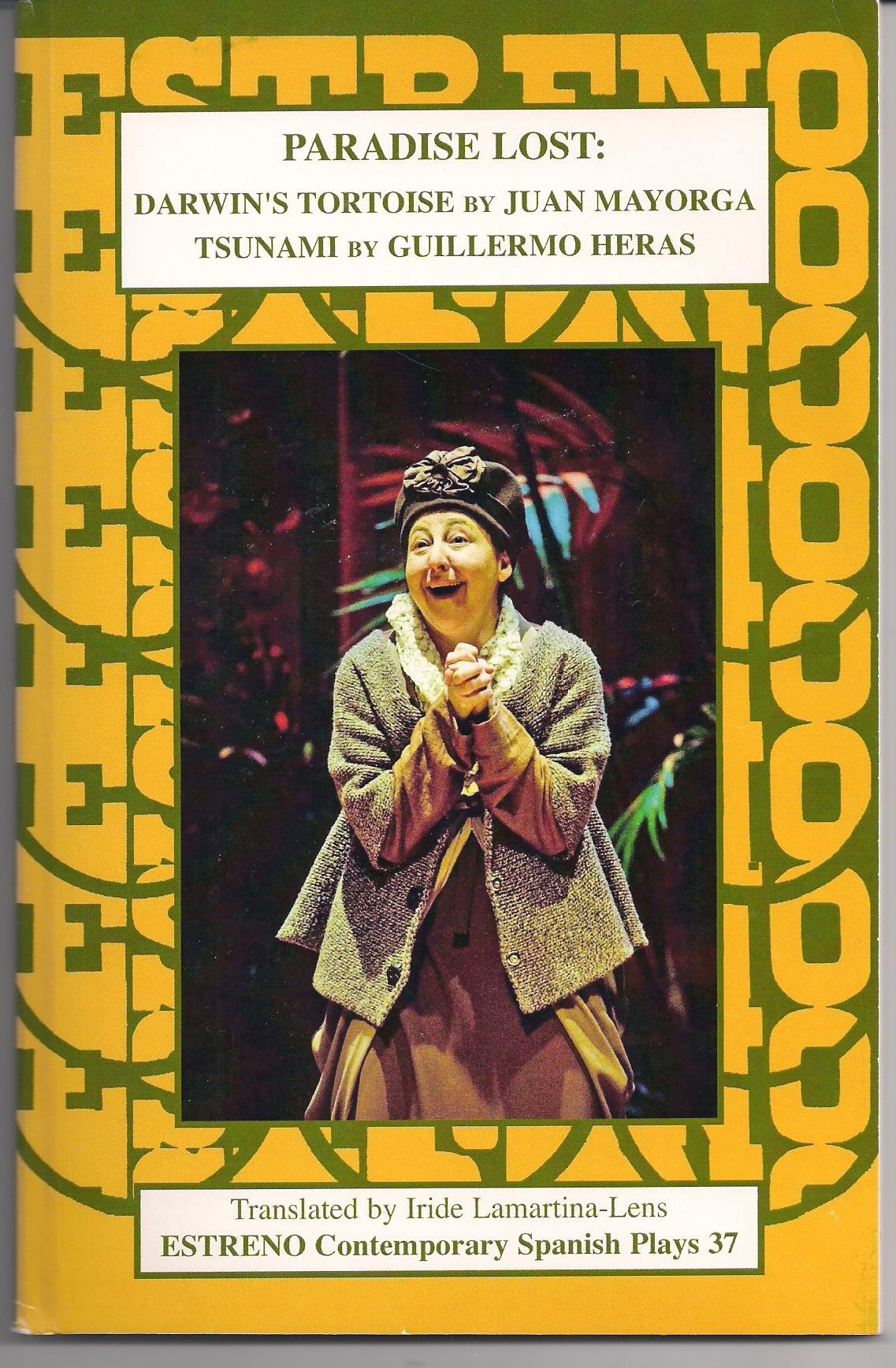N.º 6 De fuera vendrá. Traducciones y teatro extranjero

La distopía traducida
Eileen J. Doll
Loyola University New Orleans
MAYORGA,Juan y HERAS, Guillermo
Paradise Lost: Darwin’s Tortoise by Juan Mayorga;Tsunami by Guillermo Heras
Trad. Iride Lamartina-Lens. Millstone Township, NJ,
2014. Col. «Estreno Contemporary Spanish Plays, 37».
91 pp. ISBN: 978-1-888463-33-0.
¿Qué pasa cuando el sueño se convierte en pesadilla? ¿Qué pasa cuando degenera en distopía? En cierto modo, se acerca más a la realidad. La intersección de las dos piezas publicadas en Paradise Lost se encuentra justamente en la realidad distópica.
Esta publicación en inglés de dos obras tan interesantes y comprometidas del teatro actual español hace posible la difusión de dichas obras a un público más amplio y global. Los temas son, seguramente, globales. Las traducciones de Iride Lamartina-Lens abren las obras a un mundo de posibilidades de representación en inglés, de estudios en las universidades norteamericanas o británicas y de lectores en muchos países del mundo.
Cada pieza es precedida de una introducción breve pero concisa en inglés de un experto (Linda Materna, Jerelyn Johnson, David Hitchcock) sobre el conjunto de la obra del dramaturgo y unos comentarios críticos acerca del drama en cuestión, adecuados para orientar al público no especialista en los temas, el estilo y la trayectoria de cada autor. El libro también incluye una foto de cada dramaturgo y otras de la representación de 2008 de La tortuga de Darwin en el Teatro de la Abadía en Madrid, además de dos fotos de otra representación de la misma pieza en Seúl en 2009, en el Seojong M. Theater, las cuales muestran el interés internacional de dichas obras y añaden el aspecto visual que ayuda a la lectura de una obra teatral.
El hilo que enlaza estos dramas es la crítica a la falta de valores morales en la sociedad industrializada, demasiado preocupada por la ciencia, la tecnología, la comercialización y la explotación. Darwin’s Tortoise, de Juan Mayorga, opta por una lente cómica matizada por lo serio y a veces lo trágico al representar los vaivenes de Harriet, la tortuga que Charles Darwin llevó a Inglaterra en 1836 y que evolucionó tanto que hoy en día pasa por una ancianita. Tsunami, de Guillermo Heras, presenta todo a través de una lente onírica, sin aspectos cómicos.
En Darwin’s Tortoise, Harriet se presenta en el despacho de un célebre profesor de Historia para contar su vida y corregir los errores del famoso historiador. De ahí vienen comentarios críticos sobre los académicos que se pasan la vida tratando de impresionar a los demás, entre otras opiniones cínicas. La perspectiva de Harriet hacia la vida se contrapone como una visión fresca, clemente y más humana que la de los seres humanos. Como se ve en otras obras suyas, Mayorga utiliza magistralmente a los animales no humanos para representar a los seres explotados, manipulados y desechados de nuestras sociedades. Las Islas Galápagos parecen ser la utopía que le fue robada a Harriet para meterla en el mundo “civilizado” de Europa, y que Harriet ahora sueña con recuperar. La tortuga/mujer está harta de los animales humanos que, en su opinión, han involucionado.
De manera paralela aunque más breve, Tsunami, de Guillermo Heras, critica la manía de la sociedad moderna de explotar los paraísos del mundo, en este caso en particular, Sumatra. La protagonista, Ingrid, se encuentra en una habitación completamente gris mientras unos Hombres (¿doctores?, ¿detectives?) tratan de devolverle su memoria. Ingrid no quiere recordar su pasado; solamente quiere volver a Sumatra, a la isla tranquila de antes de la tragedia. No se revela mucho del pasado de Ingrid, ni de su tiempo ni sus motivaciones para pasar las vacaciones en Sumatra, pero insiste una y otra vez en que no quiere recordar su pasado. El mundo, para ella, consiste en una habitación gris, que quiere desesperadamente dejar atrás, y su recuerdo de unos días en Sumatra que culminan en el tsunami y la destrucción. Lo que sí aprende el público es que los habitantes de Sumatra viven de los turistas, que a su vez destruyen hasta cierto punto el paraíso del lugar que han venido a gozar.
En las dos obras hay una figura femenina que los hombres tratan de manipular. Las dos quedan atrapadas en este mundo distópico, aunque es muy posible que Harriet se escape y vuelva a sus islas porque su lema siempre ha sido “adaptarse”. El final de Darwin’s Tortoise es abierto y optimista, mientras el de Tsunami, aunque también abierto, parece bastante pesimista. La cuestión palpitante queda para los lectores/espectadores: ¿podemos escaparnos de esta distopía que nos hemos creado?

Dystopia translated
Eileen J. Doll
Loyola University New Orleans
MAYORGA,Juan y HERAS, Guillermo
Paradise Lost: Darwin’s Tortoise by Juan Mayorga;Tsunami by Guillermo Heras
Trad. Iride Lamartina-Lens. Millstone Township, NJ,
2014. Col. «Estreno Contemporary Spanish Plays, 37».
91 pp. ISBN: 978-1-888463-33-0.
What happens when a dream becomes a nightmare? What happens when it devolves into a dystopia? In a way, it becomes closer to reality. The intersection of the two plays published in Paradise Lost is found precisely in this dystopic reality.
This publication of the English translation of two such interesting and socially engaged plays from current Spanish theatre makes their dissemination possible to a wider, more global audience. The themes of the works are definitely global. Iride Lamartina-Lens opens the works to a world of possibilities through her translations: productions in English, studies in North American o British universities, readers in various countries of the world.
Each play is preceded by a brief but concise introduction by an expert (Linda Materna, Jerelyn Johnson, David Hitchcock) on the entire canon of the dramatist and some critical comments about the work that follows. These are sufficient to orient the non-specialist to the typical themes, the style and the overall career of each author. The book also includes a photograph of each dramatist as well as a few photos from the 2008 production of La tortuga de Darwin at the Teatro de la Abadía in Madrid and two from the production of the same work in Seoul in 2009 at the Seojong M. Theater. The photos show the international appeal of these dramas and add a visual element helpful when reading plays.
The common thread linking the two dramas is a criticism of the lack of moral values in today’s industrialized society, which is too preoccupied with science, technology, commercialization and exploitation. Darwin’s Tortoise, by Juan Mayorga, uses a comic lens tinged with serious and sometimes tragic edges to represent the ups and downs of Harriet, the titular tortoise that Charles Darwin transported to England in 1836; Harriet has evolved so drastically that now she can pass for a little old lady. Tsunami de Guillermo Heras presents the action through a dream-lens, without any comic elements.
In Darwin’s Tortoise, Harriet appears in the office of a distinguished history professor to share her life story and correct the errors of the famous historian—hence the critical commentaries on academics who spend their lives trying to impress others, among other cynical observations. The three humans who “take care” of Harriet really view her as a way to gain money, fame and success; they neither consider her with any compassion, nor treat her with the respect due someone with so much life experience. Harriet’s perspective towards life is set in contrast to that of the humans and is a fresh, merciful and more humane view. As with other of his plays, Mayorga does a masterful job of presenting non-human animals as symbols of exploited, manipulated, expendable members of our societies. The Galapagos Islands seem to be the utopia that was taken away from Harriet only to subject her to the “civilized” world of Europe, and it is that which Harriet dreams about recovering. The tortoise/woman has had enough of the human animals who, in her opinion, have devolved.
Tsumani by Guillermo Heras, in a parallel but less extensive way, also criticizes the fixation of modern society on exploiting the paradises of the world, in this particular case, Sumatra. Ingrid, the protagonist, finds herself in a completely gray room with some Men (doctors? detectives?) trying to bring back her memory. She does not want to remember her past, only return to Sumatra, the peaceful island of before the tragedy. Very little of Ingrid’s past is revealed, neither of her stay in Sumatra nor the reasons for spending her vacation there, but she keeps on insisting that she does not want to remember the past. The world for her consists of a gray room, which she desperately wishes to leave, and her memory of a few days in Sumatra which culminate in the tsunami and destruction. What the audience/readers do learn is that the inhabitants of Sumatra live off the tourists, who in turn destroy some of the paradise they come to enjoy.
In both works there is a female figure that men try to manipulate. Both protagonists stay trapped in this dystopian world, although it is very possible that Harriet will escape and return to her island because her slogan always has been “adapt.” The ending of Darwin’s Tortoise is open and optimistic, whereas the ending of Tsunami, although also open, seems rather pessimistic. The burning question remains for the readers/spectators: can we ourselves escape this dystopia that we have created?



